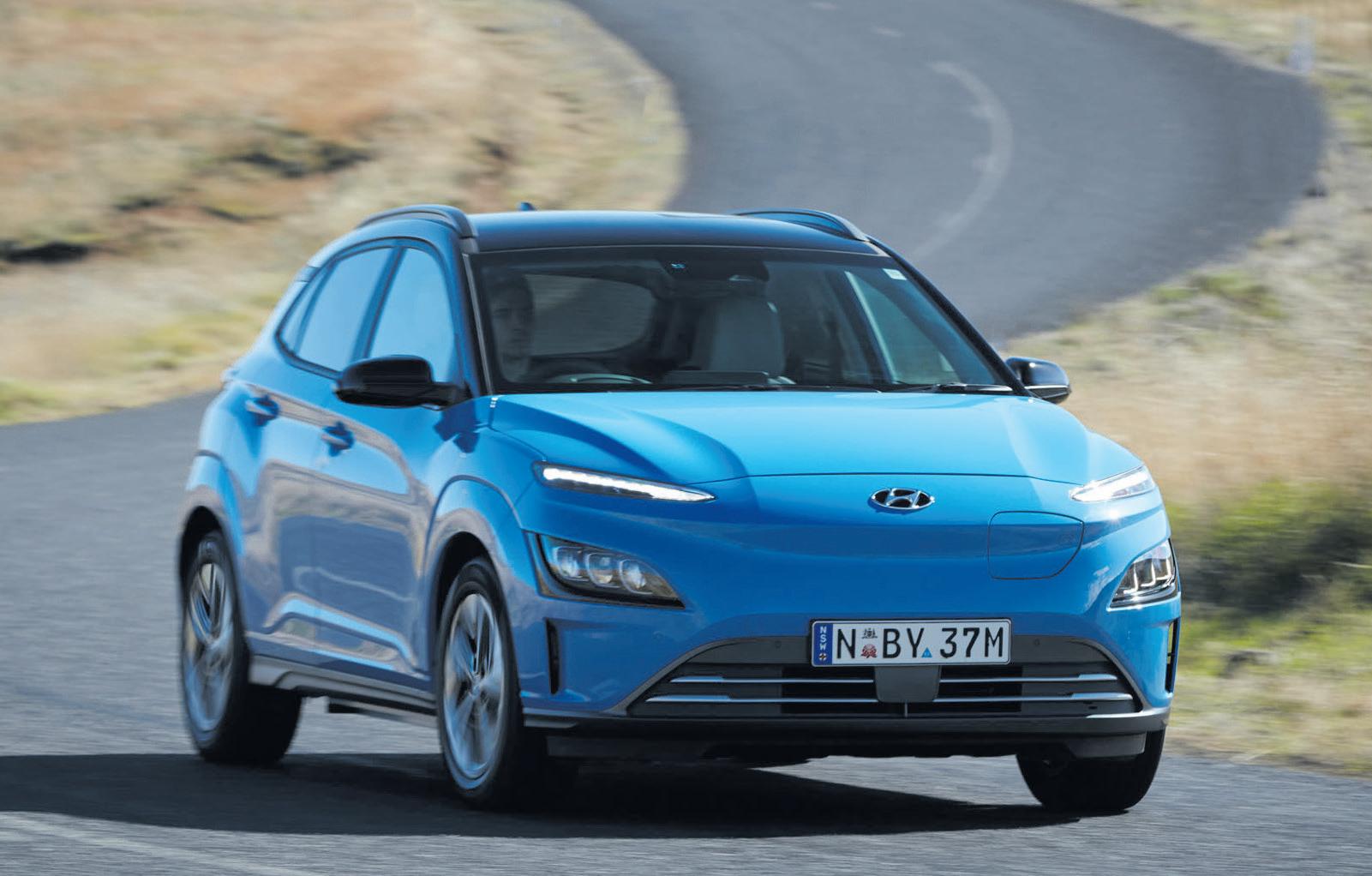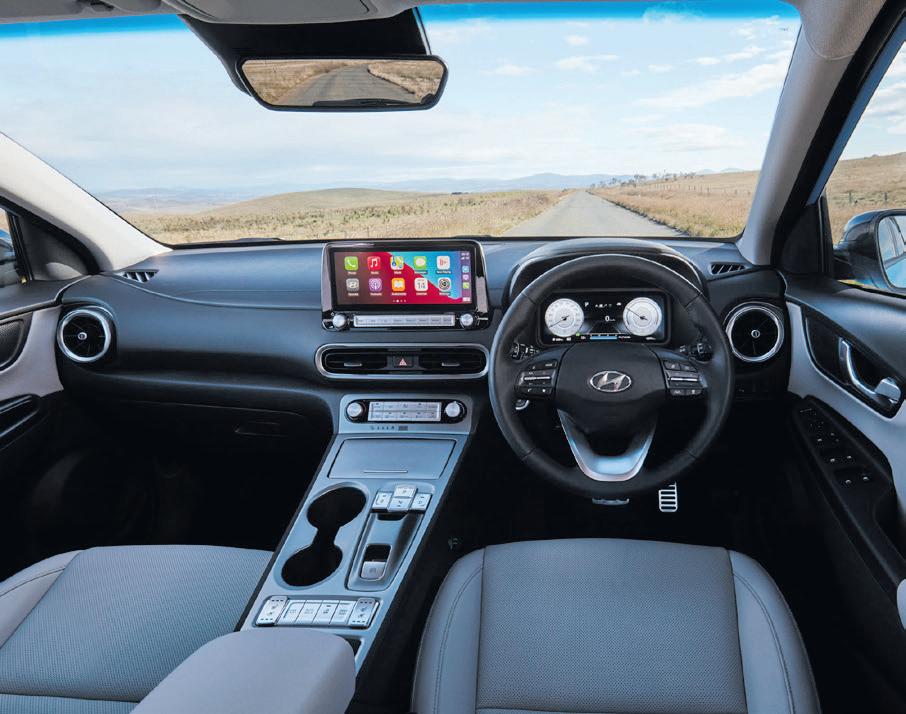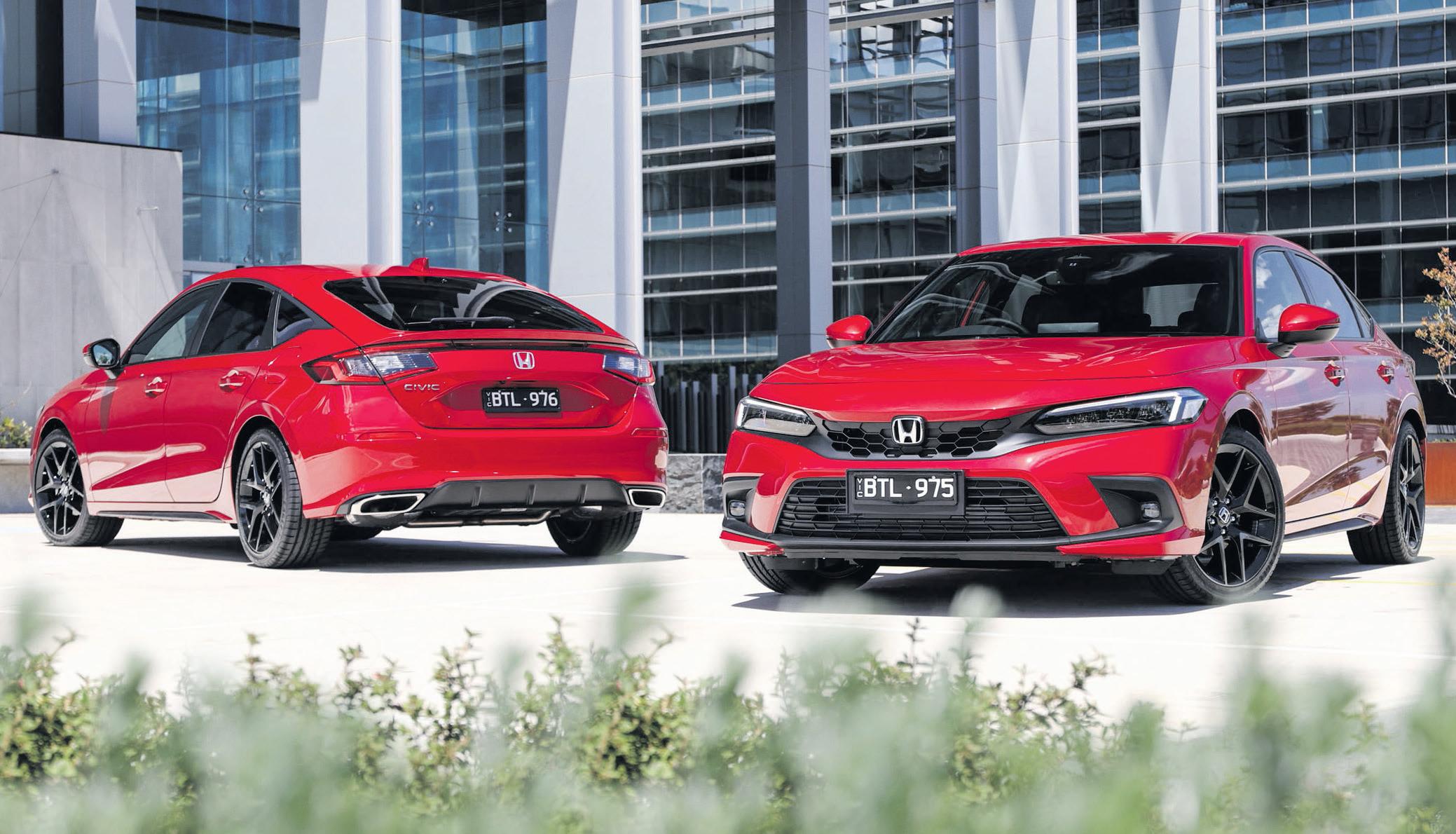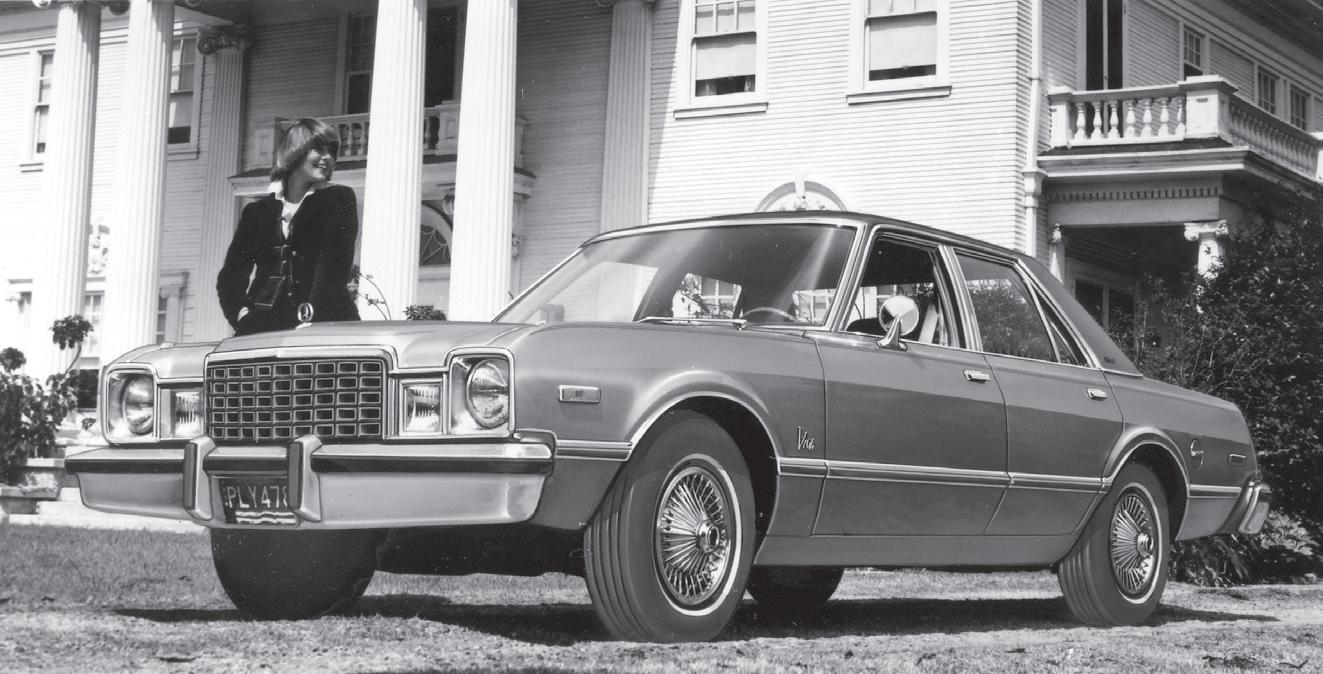
13 minute read
Motoring
Kona Highlander has a closed front that show it’s an electric vehicle HYUNDAI KONA HIGHLANDER ELECTRIC
By EWAN KENNEDY
Korean car maker Hyundai is very serious about being at the forefront of the vehicle design. It produces a variety of sizes, with the Kona being the second smallest of them.
It’s also very serious about minimising the amount of greenhouse gases being sent into the atmosphere. Hence a range of electric vehicles, both pure electric and petrol / electric hybrids.
STYLING
Kona Highlander has a closed front which immediately lets people know this is an electric vehicle, not one powered by petrol or diesel. At the lower part of the front there’s a black section with a couple of horizontal bars to take away some of the plainness of the front
The CCS Type 2 charging port is behind the upper part of the front and is easy to plug into.
There are multiple segments in the very slim horizontal headlights. These look great and really tie in nicely with the futuristic look of the car-of-the-future which will be pure EV in everincreasing numbers.
The black colour on the wheelarches and the side skirts are there to give it the look of a small SUV, rather than a family hatchback. We liked the design as did most of the people we showed it to. Though some felt that it was rather bland in the upper sections and needed something to lift it in style.
There’s a wave-shaped rear bumper and 17-inch alloy wheels, the latter are unique to this variant of the Kona,
INTERIOR
The dashboard is quite stylish, with twin screens, one in the front of the driver with twin circular dials. The centre screen has a decent sized one that’s easy to use.
The portrait style screen in the centre doesn’t display as far ahead as landscape screens, something that is sadly too common as it doesn’t show a long way ahead on the map when you’re using it for navigation.
There is seating for fve, although the centre rear seat is on the tight side. The seats are higher in the electric Hyundai as there’s a large battery under the foor. As always, we advise that you take potential rear seat occupants to the car showroom to try them for size.
Kona Highlander has power adjustable front seats which are heated and cooled. In the rear the outer rear seats are also heated. Just the thing for wintery weather, there’s also a heated steering wheel. Even though we live on the Gold Coast it does get pretty cool overnight so these heating functions were enjoyed.
The boot has a net to carry around the public charging cables. Under the foor there isn’t a full-sized spare wheel, however there a tyre repair kit and a tidy storage case for the wall socket charging cable.
INFOTAINMENT
Hyundai Kona Highlander has a Harman Kardon premium audio system with eight speakers and an external amplifer. It has AM, FM and DAB+ radio. An interesting feature is what Hyundai calls “Quiet Mode” that limits the volume of the sound. Teenagers may not like this, but mum and dad surely will! electric is powered by a permanent magnet synchronous motor producing up to 150kW and 395Nm. It drives the front wheels through a single-speed transmission that
varies from moment to moment to produce the best ‘ratio’ for the circumstances.
The Kona’s battery pack is a Lithium-ion unit and is charged through a single European-standard Type 2 CCS port.
SAFETY
The Highlander has Hyundai’s SmartSense features. These include freeway-speed automatic emergency braking with pedestrian and cyclist detection; lane keep assist with lane departure warning; blind spot monitoring; collision assist; rear cross-traffc alert; and reversing automatic braking.
It also has adaptive cruise control with stop and go function, driver attention alert, safe exit warning, and rear seat occupant alert.
Kona transmits a noise at low speeds to alert pedestrians of its presence.
DRIVING
Some of the charge in the battery is recovered
when you use the brakes. You can vary the amount of this regeneration by using paddle-shifters on the steering wheel.
In its mildest mode, deceleration once you lift off the accelerator is relatively small. Medium increases regeneration but you still need you to use the brake pedal to come to a complete stop.
In the most aggressive setting, you can drive the Kona EV as a onepedal car - that is by the accelerator only without the need to touch the brake pedal. It can be a challenge for the less experienced driver, timing the use of the accelerator so that the car comes to a stop at just the right place. This is quite enjoyable as keen drivers like to get the best from their car in all circumstances.
It’s fun in other ways too as the instant acceleration is great. Touch the Go pedal and you immediately go faster. There’s none of the hanging around till the computer on an internal combustion engine gets its message from the accelerator, works out what fuel fow is needed and which gear the to select.
There are three levels of regenerative braking with the maximum setting it becomes a single-pedal vehicle that bring Highlander to a stop quickly after letting taking your foot of the accelerator.
Thanks to local suspension tuning it handles nicely, though you do feel it’s on the heavy side due to the added weight. On the other hand, the batteries are low down and this centre of mass is better than in the internalcombustion engines in other Konas.
The holographic head-up display on the windscreen is handy. But if you’re wearing polarised sunglasses, as I do, the display is only visible if you tilt your head slightly to one side or the other. Very irritating…
During our test period we covered 270 kilometres on a variety of roads - motorway, country on fat surfaces, country in hill areas, and in boring suburban driving. When we fnished the week’s testing it had an indicated 180km to ‘empty’ showing.
OUT OF 10

Looks: 8/10 Performance: 9/10 Safety: 7/10 Thirst : 8/10 Practicality: 8/10 Comfort: 7/10 Tech: 9/10 Value: 6/10
AT A GLANCE
MODEL RANGE Kona Elite EV Standard Range: $54,500 Kona Elite EV Extended Range: $60,500 Kona Highlander EV Standard Range: $58,000 Kona Elite Highlander EV Extended Range: $64,000 Note: These prices do not include government or dealer delivery charges. Contact your local Hyundai dealer for drive-away prices.
SPECIFICATIONS
(Hyundai Kona Highlander EV Standard Range)
ENGINE:
Capacity: NA Confguration: NA Maximum Power: 100 kW Maximum Torque: 395 Nm Fuel Type: NA Combined Fuel Cycle (ADR 81/02): NA CO2 Emissions: NA
DRIVELINE: Single speed automatic
DIMENSIONS, WEIGHT AND
CAPACITIES: Length: 4180 mm Wheelbase: 2600 mm Width: 1800 mm Height: 1555 mm Turning Circle: 10.6 metres Kerb Mass: 1535 kg Fuel Tank Capacity: NA
BRAKES:
Front: Ventilated disc Rear: Solid disc
STANDARD WARRANTY:
Five years / unlimited kilometres
USED CAR CHECKOUT HONDA CIVIC VTI-LX
By CHRIS RILEY
This is the latest in a long line of Civics. It’s a smooth, refned, urbane motor vehicle that’s easy, comfortable and rewarding to drive.
But I wonder if Honda has done enough to justify the sharp increase in price, with just the one model and no sedan on offer, arguably the better looking of the pair?
I understand why Honda has culled the lineup, with sales of sedans and hatches in decline across the new car market.
Just a couple of weeks ago Ford announced it was cutting the Focus ST, Focus ST X and Fiesta ST models -- until now bonafde fag bearers for the brand.
It’s been 50 years since the frst Civic landed in Australia, but like the Falcon and Commodore, unless the public responds positively and in numbers it could well be the last Civic, we see.
Honda says the arrival of the all-new, 11th-generation Civic is the frst step in a three-phase rollout for its iconic small car in Australia.
A hybrid is set to join the line-up later in the year followed by the much anticipated, highperformance Type R version which is sure to be a cracker.
STYLING
New Civic looks discernibly different, at least from the rear and it’s lost those huge, Volvoesque, some might say ugly tail lights (wonder if this is the start of something new).
On the fip side, the car doesn’t stand out from the crowd in quite the same way as it used to. If anything, the styling is more mainstream.
Prices start and fnish at a fxed, driveaway $47,200 across this great land of ours. There will be no negotiation, as Honda aims to make purchase a less daunting, haggle-free experience.
To put the new car in perspective, the previous VTi-LX was priced from $35,590 plus on-roads. What do you get for the extra $11K or so plus onroads?
The body is stiffer with a wider track and longer wheelbase which means better ride and handling.
The 1.5-litre turbocharged petrol engine produces fractionally more power and torque, while the CVT transmission has been updated with the addition of sport mode.
Inside, there’s a couple of extra airbags, a larger 9.0-inch touchscreen, new navigation system, DAB+ digital radio, wireless phone charging, premium Bose audio with support for wireless CarPlay -- and an instrument panel that is at least partially digital.
Vale LaneWatch, the passenger side, rear-view camera system that has been a feature of Hondas for so long. It’s gone but not forgotten, replaced by a proper blind spot alert system.
Other kit includes 18inch alloys, LED lighting all round, adaptive cruise control with stop/go, surround-view camera, keyless entry and start, automatic lights and wipers, auto-dimming rear-view mirror and interior ambient lighting.
Wait a minute . . . isn’t it supposed to be fully equipped? What about a sunroof? I hear you ask. What about head-up display and where are the parking sensors?
The navigation lacks speed sign recognition and camera warnings and the instrument cluster can’t be confgured to show different home screens and information?
INFOTAINMENT
The new high-defnition 9.0-inch colour touchscreen, infotainment and audio system features built-in, off-line satellite navigation, DAB+ digital radio, AM/ FM radio, Qi-compatible fast wireless charging, together with wired Android Auto and wireless Apple CarPlay.
Sound comes from a Bose 12-speaker audio system, featuring Bose Centrepoint 2 and Bose Surround Stage digital signal processing, putting the listener in the centre of the sound no matter where they are seated.
There are four 2.5A USB ports, with two in the front and two at the rear of the

PLYMOUTH VOLARE

1978 Plymouth Volare. By DAVID PIKE
In the USA the Plymouth’s Volare replaced the Valiant in 1976. Introduced in 1960, the Valiant had had a very long model run proving to be such reliable transport that it was kept in production for 16 years as good sales continued to be sustained. The slightly sportier Dodge version was initially named the Lancer, then later the Dart. The key to its success was the performance of the OHV Slant-Six engine which was available as either a 2.7-litre version developing 85kW or a more powerful 3.6-litre version. The engine’s description was derived from the fact that it was mounted in an angled position.
When the Volare was introduced, it was powered either by a detuned version of the 3.6-litre which developed 75kW as the base model’s power source or one of two V8 OHV engines of 5.1 or 5.8 litres which were rated at 112 and 127 kW respectively.
Unlike the Valiant, the Volare only survived for a little over two years as it soon developed a reputation for poor performance together with record-breaking recall notices as body rust became increasingly evident when cars aged.
All this occurred at a time when petrol was becoming more expensive and Japanese cars were winning the economy stakes. In spite of these woes 291,919 Volares were sold in 1976 and 382,418 in 1977.
Whilst the Valiant was a very basic car with few frills which provided reliable transport the Volare had a much more glamorous exterior.
To attract buyers the Volare had a much more distinctive appearance with smarter grille, vinyl roof, new wheels and whitewall tyres and also featured a new heavyduty suspension. This was claimed to give the occupants a more comfortable ride. centre console.
ENGINES / TRANSMISSIONS
The 1.5-litre turbocharged petrol four-cylinder engine has been tweaked to produce 131kW of power at 6000 revs and 240Nm of torque from 1700-4000 revs -- an increase of 4kW and 20Nm (the latter fgure is signifcant).
It will happily run on standard 91 unleaded, but if you stick premium in -- you get another 3kW. Transmission is via a Continuously Variable Transmission with 7-steps, gear change paddles and drive to the front wheels.
SAFETY
New Civic is yet to be crash tested by ANCAP (previous model is still waiting too).
It adds knee airbags for driver and front passenger, bringing the total to eight, plus improved pedestrian protection and an all-new wide-view, single-camera Honda Sensing system.
There’s also new Traffc Jam Assist, updated Adaptive Cruise Control and Lane Keep Assist System, as well as Blind spot information system and Rear Cross Traffc Alert.
DRIVING
My wife remains unimpressed, but I reckon the new Civic is a sweet thing.
The cabin has a more premium feel, compared to the hard plastics of the previous model, with two-zone climate air, black leatherette seats with red accented suede, plus heated and power adjustable front pews.
The touchscreen has been moved to the top of the dash as is the vogue, with a hand rest to steady your fngers as they attempt to cope with bumps in the road.
A long thin honeycomb grille that hides the air vents is an inspired touch and it is good to see the addition of rear air vents for back seat passengers.
But the dash is half-baked, with two traditional looking round analogue dials, the right one a standard analogue speedo while the left one acts a tacho with digital driver information display in the centre.
It will show navigation prompts, but that’s about the extent of it.
The dash from 0-100km/h takes a middle of the road 7.5 seconds. Fuel consumption from a smallish 47-litre tank is a claimed 6.3L/100km (same as before). We were getting 6.9L/100km after 540km of mixed driving.
By far and away the best aspect of new Civic is the comfort and quality of the ride.
The previous model was good, this one is outstanding.
Rear legroom is good, but the plunging roofine makes access diffcult -- watch you head. The infotainment system has a physical volume knob plus physical buttons for Home and Back functions, with large easy-to-recognise icons, a fast processor for quicker response time and simplifed navigation structure with fewer embedded menus.
While it’s good to see satellite navigation included, it does not have speed sign recognition, nor any speed camera or school zone warnings.
As well as Sport and Economy modes, gear change paddles are provided to move through the CVT’s seven “steps” manually. But you can’t change gears manually using the transmission lever.
After trying both Sport and Economy modes we were happy to leave it at the default.
The broad spread of torque, available from 1700 to 4000 revs, provides effortless performance, while the CVT is remarkably smooth.
It also steers and handles well to a point, although it can become foaty hustling over uneven backroads as the suspension unloads.
Good one Honda.
Civic is covered by a 5-year, unlimited-kilometre warranty, with fve years of roadside assistance and map updates. The service cycle is a relatively short 10,000/12 months, with the frst fve services capped at $125 each.
SUMMING UP
I like it. The stumbling block is the price. Civic is being promoted as one, fully-equipped model. While it excels at the basics, it falls short of competitors when it comes to the bells and whistles.
Where’s the sunroof, seat cooling, head-up display, not to mention the 10.2-inch digital instrument cluster that the car is offered with overseas?
For the price I’d expect and demand more.









